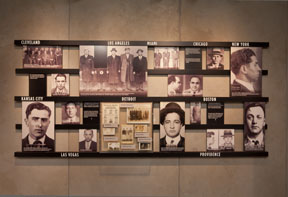| << Back |
Cultural Scene and Heard: Made in America – The Mob Museum
By
Mike Sweeney
Wise guys and made guys have long formed an indelible part of the history of Las Vegas. While Martin Scorsese’s film Casino brought the stories of Frank “Lefty” Rosenthal and Tony “The Ant” Spilotro into the spotlight, the mob’s legacy in Sin City and throughout America goes back decades further. The newly opened National Museum of Organized Crime & Law Enforcement, better known as The Mob Museum, paints a vivid picture of the notorious gangsters and intrepid lawmen who clashed in a furious battle that forever changed the face of modern history.
Public Enemies
Housed in the former federal courthouse and U.S. Post Office building downtown, the museum offers an all inclusive chronicle of organized crime through three floors worth of photographs, films, historical artifacts and interactive exhibits. From the days of Prohibition to the glamour of Las Vegas and the modern era of media darlings such as John Gotti, the sordid tales of murder, corruption and criminal activity provide a fascinating window on American culture. Detailed accounts trace the mob’s involvement in racketeering, bootlegging, gambling, politics, prostitution and more, highlighting a widespread criminal enterprise with its hands in just about everything. As infamous gangster Meyer Lansky once said, “We’re bigger than U.S. Steel.”
Interactive exhibits such as touch screen panels provide an encyclopedia’s worth of information to read through and explore. This is one museum that encourages you to be hands on, whether it’s test firing a simulated Tommy gun with some real kick or taking a seat in the actual electric chair from Sing Sing prison, where Louis “Lepke” Buchalter of Murder, Inc. met his fate. Artifacts housed behind glass provide a tangible sense of history, from old ledgers and fingerprint records to weapons favored by merciless hit men to astounding features such as the barber chair where Albert Anastasia was killed and the actual murder wall from the St. Valentine’s Day Massacre, still riddled with bullet holes from Al Capone’s ruthless thugs.
On the Case
We also get a good picture of the battle from the other side of the line, where noble G-Men such as Eliot Ness and Harry Anslinger took the fight to the mob with dedicated efficiency. A major part of the exhibit focuses on hearings led by Senator Estes Kefauver that questioned key mob players about their part in organized crime. An entertaining film projected on three screens in the old courtroom brings the hearings to life with dramatic reenactments. The ground floor traces efforts of the Department of Justice and other police and governmental agencies to conduct surveillance, gather evidence and apprehend mob figures. Listen to wiretap recordings and learn about informants and undercover operatives such as FBI agent Joe Pistone (aka Donnie Brasco).
The House Always Wins
Naturally, the mob’s history in Las Vegas forms a big part of the museum. As Dean Martin plays in the background, you’ll find walls of photos recounting the glitz and glamour of old Vegas, tracing its rise from 1950s boomtown to the days of the Rat Pack and Howard Hughes, when forgotten hotels such as the El Rancho and Desert Inn were still hot properties. Here you’ll learn about the legendary “Black Book” that kept mobsters banned from casinos, battles with the Nevada Gaming Commission and how big time gangsters like Frank Costello profited by skimming money from major casinos such as the Tropicana. There’s even a display featuring mementos and court documents from defense attorney and former mayor Oscar Goodman.
While Las Vegas will always share a notorious connection with organized crime, The Mob Museum doesn’t seek to either embrace or condemn that legacy. Rather, it presents a detailed account from both sides of the law and allows visitors to form their own opinions. The result is an entertaining and educational experience that anyone with a passion for history can appreciate.
For more information on The Mob Museum, visit www.themobmuseum.org.








